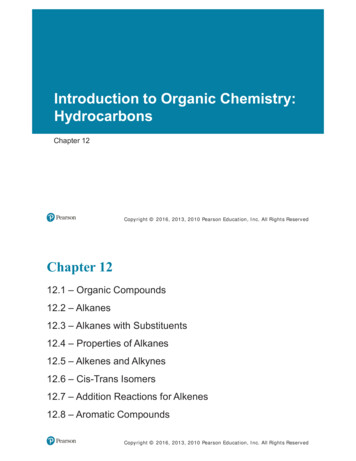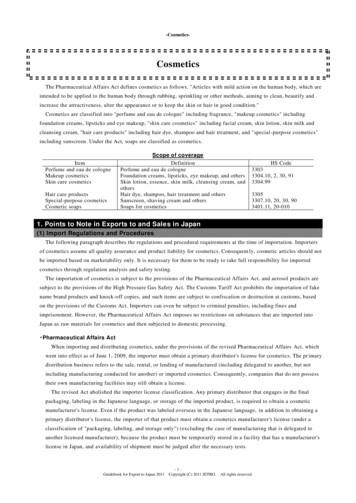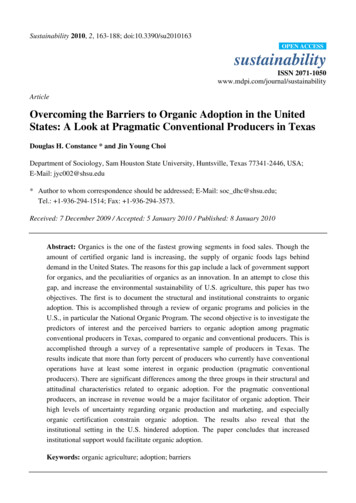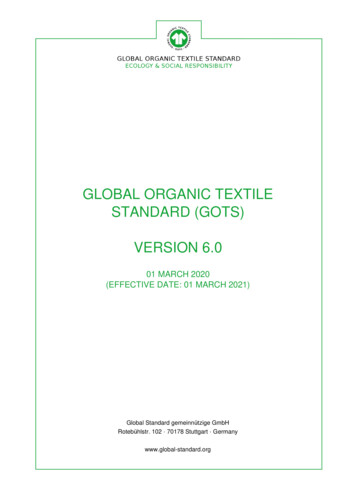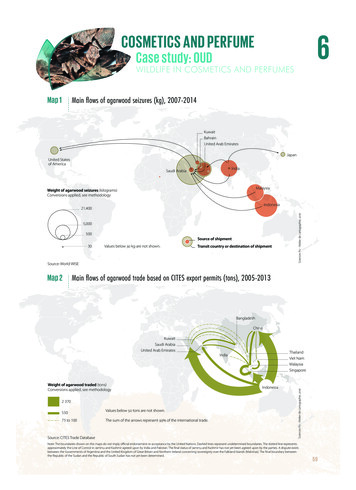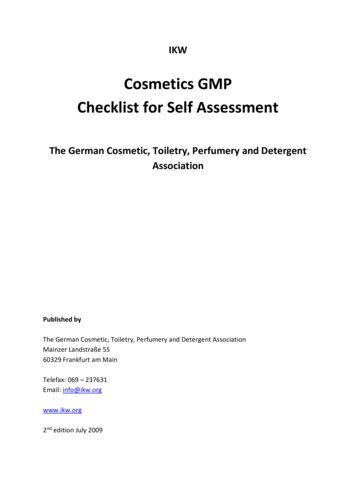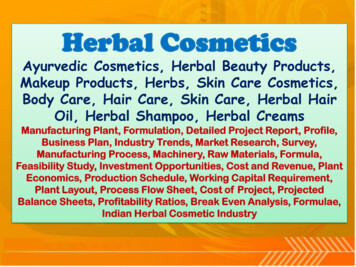
Transcription
ReviewJournal of Cosmetology & TrichologyVolume 6:2,2020DOI: 10.4172/2471-9323.1000143ISSN: 2471-9329Open AccessNatural and Organic Cosmetics: Definition and ConceptsCleber Barros* and Rosana Bevenuto Guilhen BarrosR&D department, Vinia Pesquisa e Treinamento, Campinas, BrazilAbstractThe market of natural and organic cosmetics has been growing in last decades. The increase in interest in this type of product is a consequence of the concern thatconsumers have been presenting in relation to the environment and health. In addition to the appreciation the use of sustainable ingredients in cosmetic formulations, theconsumers are also concerned about pollution caused by the use of plastics, which leads industries to reinvent themselves and rethink about the composition ofpackaging. The factor that most drives the purchase of natural and organic cosmetics are the fact that the consumer, in addition to contributing to the preservation of theenvironment, is also using a sustainable product. The growing demand for natural and organic cosmetics results in a concern of the brands with the organic issue, withthe decreased use of animal derived ingredients and with the updating the parameters required for certification of a cosmetic as natural or organic. Due to the few studiesavailable in this area, the importance of clarifying the definitions and concepts of natural and organic cosmetics is evident, in order to contribute with accurate informationfor the cosmetic sector.Keywords: Natural cosmetics Organic cosmetics Green cosmetics Cosmetology CertificationIntroductionMethodsThe use of natural cosmetics is growing among the population.Beauty products considered as natural bring an approach ofassociation between the environment preservation and healthprotection. Thus, consumers of that kind of cosmetic search forproducts with the guarantee that they are really natural [1].The present research was performed by literature review,searching for scientific articles in databases such as PubMed,Scholar Google and Scielo. For the online research, specific termssuch as natural cosmetics, green cosmetics and organic cosmeticswere used. In addition, the literature review was also carried out onbooks, magazines, related sites and certifiers of natural and organicproducts.Nowadays, the certification of organic cosmetics according to thelaw 10.831/2003 (brazilian organic regulation) is undefined. Thespecific Normative Instruction has not yet been published by MAPA(Ministry of Agriculture, Livestock and Food Supply) or ANVISA(Brazilian National Health Surveillance Agency). Therefore, a way ofdealing with this scenario is follow the orientations passed byrenowned products certifiers. According to some certifying referencessuch as NATRUE and COSMOS-standard, natural cosmetics aredefined as products that take in account, during its manufacturingprocess and life cycle, some points as: use raw materials andmethods of production considered more sustainable, work withsmaller amounts of ingredients (minimalism) and preserve the safetyof their use while becoming less harmful to the environment, inaddiction to have a recyclable packaging.Seen this, we have a consumer profile that becomes increasinglydemanding in relation to this matter. This type of consumer has beenaround for a long time, but it had its boom a few decades ago. Theyare consumers who care about the environment and biodiversity, andwho do not accept that their products are tested on animals and, forthese reasons, agree to buy more expensive products, as long asthey meet all these.*CorrespondingDiscussionConceptsThe relevance in the formulation of natural and organic cosmeticsis involved not only in the treatment of skin itself, but also aims thequality of life that the consumer will have when choosing to use anatural cosmetic instead of a conventional cosmetic. Owing to thehigh variety of ingredients considered as naturals that can be usedsafely in final cosmetic products, this study area is very promising [2].Products considered as natural tend to have green characteristics,due to the fact that consumers are concerned not only with the finalproduct they will use, but also with the entire production process,such as recyclable packaging and consistent use of naturalresources, for example. Furthermore, the process by which the rawmaterial is obtained is also taken into consideration (use oftechnologies considered less aggressive to the environment).author:Cleber Barros,ViniaPesquisa e Treinamento, 360 Orosimbo Maia Avenue, Campinas, SP, 13010-211, Brazil, E-mail:- cleber@vinia.digital; Tel.: 5519 3236-4345Received: June 08, 2020; Accepted: June 22, 2020; Published: June 29, 2020Copyright: 2020 Barros C, et al. This is an open-access article distributed under the terms of the creative commons attribution license which permits unrestricted use,distribution and reproduction in any medium, provided the original author and source are credited.
Barros C, et al.J Cosmo Trichol, Volume 6: 2, 2020As stated by IFOAM (International Federation of OrganicAgriculture Movements), ingredients with organic certification arenatural substances and derived natural substances from controlledorganic farming certified by a duly recognized certification.In this period, the extracted ingredients were perfumed, such asanise, pepper, rosemary, sage, peppermint and lemon balm. Aroundthis same time, perfume shops also started to appear, selling solidunguents, oily liquids and powders.It can be said that in the last two decades the number of studiesthat prove the benefits of using natural ingredients has increased,both in cosmetics for dermatologic and hair care and for thetreatment of diseases. For example, has been proved that colloidaloatmeal promotes better treatment of psoriasis and aloe vera hasbenefits in treatments of atopic dermatitis. In the case of stainreduction, it was shown that licorice, green tea, arbutin, soy, açaiberry, turmeric and pomegranate offer benefits in reducinghyperpigmentation due to its antioxidative action [3].Ancient EastThe concept of natural and organic cosmetic ingredients isconstantly expanding, since both the new consumers and climatechanges occurring in the world claims for more sustainability, welfareand animal protection. Observing trends for the future, there is a lot ofcoherence in wanting to find means of production that is lessaggressive to the environment and animals, such as greaterresponsibility for the use of water, increase in the production ofsustainable packaging, not conducting tests on animals, dedication toenvironment, social responsibility and the appreciation of localproducers [4].Cosmetic historyThe cosmetic history occurs along with the evolution of thecivilized world, and its use dates back at least 30 thousand years,when cosmetics were used only with religious purposes (like burningof incenses, resins and scented woods) and also to improve theappearance of the body (living or dead). Thus, it is possible to identifythat men has always had a bond with cosmetics that has beenimproving every moment.EgyptiansAccording to recording data from the time of Cleopatra, the use ofcosmetics started in Egypt, where the queen used to be immersed ingoat’s milk in order to make her skin softer. Ingredients such ashoney, milk, vegetal flours and beeswax were commonly used by theEgyptian people, with which they were manufactured skin creams. Inthe production of makeup, were used natural lead carbonate andmercuric sulfide, and mixtures of ground charcoal and leadsulfide.And in the case of hair dyes, the Egyptians developed thoseusing henna, roasted gallnuts and iron chips.Romans and GreeksThrough the teachings that the Egyptians passed on, the Romanand Greek peoples also had a strong influence on the history ofcosmetics. Hippocrates (considered as the father of medicine),structured all the knowledge he received and started the study ofdermatology. Around 400 BC clay cosmetics were already used inGreece, known as “beauty masks”.In Rome, a doctor called Galeno(who passed away in 200 AD), besides transcribing anatomy,pharmacy and pathology subjects, also contributed to theadvancement of cosmetology with his formula “cooling ointment”, orcold cream emulsion.Page 2 of 9In the middle Ages, after the fall of Rome, the barbarians took overpower and the christianity condemned the praise of beauty. In thisway, medicine and cosmetology were left out for two centuries.However, men traveling to and from China, India, Tibet and Japanbegan to spread their acquired knowledge to the East people. Thus,the use of cosmetics continued to happen, although less intensely.During the 3rd to 5th centuries AD many types of cosmetics wereused in India, such as creams, oils, makeup and hair dyes. Eventhen, cosmetics were correlated with medicine, and started to beused in the treatment of skin diseases.Renaissance periodDuring the 13th to 16th centuries, Europe has returned to focus oncivilization and with the increase in negotiations and trades; therewas a significant development in materials related to cosmetics andperfumery. At that time, many materials were brought from the East,such as dyewoods, asbestos, zinc oxide, petroleum, spices, newcolors and the use of coal as fuel.During the Renaissance Period, in France a Venetian method wasused to bleach hair, which consisted of immersing it in soda or alum(sulfate with astringent properties) and letting it dry in the sun. InEngland, basic lead carbonate (a white powder) was used by peopleas face powder as a sign of nobility.In this period, knowledges about alcohol and distillationmechanisms advanced. In the 14th century, the first use of alcohol inperfumes was authenticated when a tincture of rosemary toilet waterrecipe was published. The attention that was given to the productionof perfumes occurred because, despite all the interests withcosmetics and beauty, the habit of not taking a shower still persisted.Modern ageDistillation methods and procedures were developed, giving rise toessential oils, fats, soaps, and other ingredients used in cosmetics. Atthat time the cosmetics were made mostly in the home, although thenumber of outside cosmetic stores was already expandingceaselessly. In France, the cosmetic market had already grownexponentially with the use of ointments, oils, depilatories andaromatic waters, in addition to everything related to perfumery.Soap was already manufactured at that time, but subject to highexcise taxes, which shows how elegant clothes and hairstyles werestill considered more important than basic hygiene, that is, the habitof not taking a shower still existed. At the time, people used analmond paste just to perform a superficial cleansing on the skin.Contemporary ageIn the England and the USA, for most of the 19th century, womenwho wore makeup (except when on stage) were looked uponimmoral. Unlike France, where women used cosmetics and makeuplong ago. It was only after the First World War that prejudice againstthe use of cosmetic by Anglo-Americans began to diminish. After
J Cosmo Trichol, Volume 6: 2, 2020Barros C, et al.World War II, the act of dyeing hair to disguise grey hair spread evenmore, allowing the growth of the hair coloring industry.Reports of the use of sunscreen dates from World War II, when aphysical blocker (red petrolatum) was issued by servicemen. The firstsale of a sunscreen occurred in the United States, in 1928, and itsactive ingredients were benzyl cinnamate and benzyl salicylate.In the 20th century the most developed countries grewextraordinarily with the production of cosmetics and cosmeticsingredients. Thus, the first cosmetic industries emerged, becoming animportant economic agent.Present and futureTechnological advances in cosmetology were too fast andadmirable. In the 1980s and 1990s a large use of alpha-hydroxyacids (AHAs) was started in several cosmetic vehicles, as they helpto reduce the appearance of wrinkles and age spots. Among otheringredients that have also started to be commonly used to combatskin aging are enzymes, vitamins and antioxidants.Regarding the concern with the preservation of the environmentand protection of health, it is possible to to highlight the attention andcare with the conservation of natural sources of chemical products,biodegradable or reusable packaging, as well as the treatment ofwaste generated.A brief history of the beginning of the naturalmovementIn 1962, with the publication of the book “Silent Spring” by RachelCarson, a debate began in the United States about the use ofchemical pesticides, as well the responsibility of science and thelimits of technological progress, which prompted the awakening ofpublic environmental awareness. This publication raised certainquestions to the government, which consented to the deliberateexposure of human beings to toxic substances that were releasedinto the environment. There was no control over the amount ofpesticides that were spread throughout the environment, as well asover the levels of exposure of living beings, which could not bemeasured either. Thus, there was no way to calculate the damagefrom long-term exposure.Many manifestations about environmental awareness haveoccurred, but the decrease in the use of pesticides has not happenedin the desired and necessary way to guarantee the safety of livingbeings. Thus, pollution has ceased to be a theory a long time agoand is a reality of modern life, so that it is necessary to reassess therelationship between the population and the natural world.According to Carson, what is of most concern is the contaminationof air, soil, rivers and seas, which in most cases is irrecoverable. Thiscontamination, caused mainly by synthetic ingredients that areincreasingly innovative. Thus, it becomes necessary to establish acontrol over the resources that are used in the production of syntheticingredients and in the use of pesticides for pest prevention,associated with the modern lifestyle.Cosmetic legislationAccording to RDC resolution nº 07 of February 2015 (Brazil),cosmetics, perfumes and personal hygiene products arePage 3 of 9“preparations made up of natural or synthetic substances, for externaluse in the different parts of the human body, skin, capillary system,nails, lips, genitals external, teeth and mucous membranes of the oralcavity, with the exclusive or main objective of cleaning, perfuming,altering their appearance and or correcting body odors and eitherprotecting or maintaining them in good condition ” . In addition,cosmetic products must follow some other rules, which provide forwhich substances are or are not allowed, such as preservativesubstances, dyes and ultraviolet filters [5].Regularization of natural and organic cosmeticproductsCurrently, there are no general rules dealing with the definition ofnatural or organic cosmetics. As there are no official norms and legalbases for the characterization of these types of products, one way ofbeing able to use the terms as “natural” and “organic” for cosmeticproducts is to stick to the guidelines of some certifying references,such as NATRUE and COSMOS-standard. First of all, natural andorganic cosmetics are defined as cosmetic products and, therefore,they must meet the standards of the RDC nº 07 of February 10, 2015(Brazil), or the standards in force in the country of origin that providesthe technical requirements for the regularization of cosmeticproducts, and therefore must meet the requirements of composition,safety, effectiveness and labeling. Only after following the basicrequirements in force in the country the product is able to beclassifying as natural and organic, through the adoption of what thecertifiers preach [6].Certifying (NATRUE and COSMOS-standard)NATRUE and IBDThe certifier NATRUE (The International Natural and OrganicCosmetics Association) is an international non-profit association thatworks promoting and disseminating concepts and practices aboutnatural and organic cosmetics. Its main objectives are to createrequirements for the definition and characterization of cosmetic andorganic products and to combat the practice of Green washing (termused to define a model of advertising that use the idea ofsustainability just by marketing strategy to attract the consumerattention) and misleading claims on market products. This guidelinehas three categories of certification for finished products, which mustfollow some requirements regarding the concentration of naturalsubstances, derived natural substances and the minimum content oforganic ingredients contained in the product [7].Each product category has a different label, informing which thecertification category is. According to NATRUE, the certificationscategories are: natural cosmetic, natural cosmetic with organicportion and organic cosmetic. Thus, the certifier also defines 13categories of cosmetic formulations that can be certified, according tothe established rules. Each category has specific rules regarding theconcentration of natural substances and derived natural substancesthat it must contain.In addition, NATRUE signed an agreement on criteria forcertification of organic and natural products with IBD (InstitutoBiodinâmico, Brazil). IBD is a certifier of organic products present inLatin America, and has accreditation with IFOAM (The InternationalFederation of Organic Agriculture Movements), ISO/IEC 17065
J Cosmo Trichol, Volume 6: 2, 2020Barros C, et al.(European market-regulation CE 834/2007), Demeter (internationalmarket), USDA/NOP (North American market) and approved for useof the SISORG (Brazilian Organic Conformity Assessment System),which makes the certificate accepted globally. Thus, NATRUE andIBD have international equivalence requirements, with mutualrecognition of standards alignment.Natural cosmeticsAccording to NATRUE, for a cosmetic to be considered as naturaland to be certified as such, it must contain a minimum level of naturalsubstances and a maximum level of derived natural substances, asshown in Figure 2.Natural cosmetics with an organic portionFor natural cosmetics with an organic portion, they must contain aminimum level of natural substances with organic certification and amaximum level of substances derived from natural, in which theirproduction (their primary ingredient) is from organic origin. So that atleast 70% of these substances must have organic certification or befrom wild collection. In the case of derived natural substances thathave been produced from certified ingredients, the content of theorganic portion will be considered and added to the organic totalamount, as shown in Figure 3.Organic cosmeticsIn the case of organic cosmetics, they must also contain aminimum level of natural substances and a maximum level ofsubstances derived from natural, in which their production (theirprimary ingredient) is from organic origin. However, at least 95% ofthe natural substances of plants and animal origin and of derivednatural substances contained in the product must have organiccertification or be from wild collection. In case of derived naturalsubstances that have been produced from certified organicingredients, the content of the organic amount will be considered andadded to the organic total amount.Permitted ingredients categoriesThere are three categories of permitted ingredients for use incosmetics, according to the NATRUE guideline: natural substancesderived natural substances and nature-identical substances.Natural substancesNatural substances are substances of botanic, inorganic-mineralor animal origin (with the exception of dead vertebrates) and mixturesof these substances that have undergone physical processes for theirextraction, that is, that do not cause changes in the naturalcomponent, such as essential oils, vegetable oils and extracts.According to the NATRUE guidelines (2019), water will beconsidered a natural substance only when it is in accordance.Depending on the ingredient used, only a few parts are considerednatural. The Table 1 shows the specification of ingredients parts thatare considered natural.Table 1: Specification of ingredients parts that are considered natural.Type of ingredientWhat is considered naturalVegetable juices100% from vegetable juiceConcentrated vegetable juicesOnly the juice, without the water used for dilutionAqueous extractsOnly the plant portionHydroalcoholic extractsOnly the plant and alcohol portions (if this is a natural substance)Nature-identical substancesNature-identical substances may only be used when a naturaloption is impossible. Examples of natural-identical substances aresome inorganic pigments, minerals and preservatives.Derived substancesDerived substances are the raw materials subjected to processesthat cause little change in the natural component and follow thepermitted reactions. They can be used only when the function cannotbe performed using a natural substance. These substances areobtained from natural substances, such as fats, oils, waxes,polysaccharides, proteins and lipoproteins. However, there are alimited number of chemical reactions accepted in the production ofthis type of ingredient. Besides that, the the raw materials of thisclass must, necessarily, be produced through processes modelled onPage 4 of 9physiological mechanisms, and should pass through the fewestconversion steps as possible. For this type of raw material, only thefollowing chemicalreactions are permitted: acylation, amidation,condensation (with elimination of water), idation,hydrogenation,hydrogenolysis, hydrolysis (including saponification), neutralisation,oxidation (with oxygen, ozone and peroxides), phosphorylation,pyrolysis, sulphatation and transesterification. Among the prohibitedreactions are: ethoxylation, propoxylation, sulfonation, phosphating,polymerization.For each of the three categories of finished products, there arestipulated levels of these substances for different types of cosmeticproducts, such as emulsions, sunscreens, soaps, among others. Thisspecification is shown in the figures below (Figures 1-3):
Barros C, et al.J Cosmo Trichol, Volume 6: 2, 2020Figure 1: Specification of the minimum concentration of natural substance and the maximum concentration of natural substance derived in naturalcosmetics.Figure 2: Specification of the minimum concentration of natural substance and the maximum concentration of natural substance derived in naturalcosmetics with organic portion.Page 5 of 9
Barros C, et al.J Cosmo Trichol, Volume 6: 2, 2020Figure 3: Specification of the minimum concentration of natural substance and the maximum concentration of natural substance derived in organiccosmetics.Prohibited ingredientsAccording to IBD, some ingredients should not be used in finishedproducts, be they natural, organic or with an organic portion. Suchingredients are: polyethylene glycols (PEGs), silicones, quaternaryammonium, diethanolamides, petroleum derivatives, geneticallymodified organisms (OMG), fragrances, dyes and syntheticpreservatives.PackagingAs stated by NATRUE, in addition to presenting the smallest sizeas possible, the packaging of natural, organic and natural cosmeticproducts with an organic portion should preferably be made ofrecyclable materials, such as glass, aluminium, paper/cardboardand/or recyclable plastics. Furthermore, products must be designedfor multiple uses (except for sample packs). The permittedpropellants are air, nitrogen, oxygen carbon dioxide, argon (butwithout volatile organic compounds). Gases will not be taken intoaccount for calculations and halogenated plastics (such as polyvinylchloride and chlorinated plastics) may not be used in packaging forthese products.General NATRUE labeling and certification rulesFor the cosmetic product line to be able to bear the certificationlabel, it must have certification of at least 75% of products of aspecific brand (or sub-brand). If there are products certified byanother certifying standard, they can be counted in the calculation of75%, to obtain NATRUE certification. However, this accounting willonly be allowed during the first two years of the certificate. After thisperiod, the brand must have a threshold of 75% of the products in theline with NATRUE certification. Double labelling is permitted as longas the above requirements are met.Page 6 of 9COSMOS-standard (BDIH, Cosmebio, Ecocert,ICEA and Soil Association)COSMOS-standard is an international non-profit associationcreated to promote and disseminate concepts and practices aboutnatural and organic cosmetics. It is formed by the union of fiveorganizations in Europe, namely: BDIH (Germany), Cosmebio(France), Ecocert (France), ICEA (Italy) and Soil Association (UnitedKingdom). Furthermore, its main objectives are promoting the use ofproducts from organic agriculture and respecting biodiversity, usingnatural resources responsibly, and respecting the environment, usingsafe and respectful production processes for human health and theenvironment and strengthen the concept of “Green Chemistry”. Thisguideline has two types of certification for finished products: naturalcosmetics and organic cosmetics.Natural cosmeticsAccording to COSMOS there is no requirement on a minimumconcentration of organic content that should be used in formulationscertified as natural, however, there is a calculation rule fordetermining the concentration of ingredients of natural origin incosmetic products (COSMOS-standard, 2019): % natural origin oftotal [weight of total product-weight of non-natural origin ingredientsweight of petrochemical moieties]/weight of all ingredients x100.Organic cosmeticsFor organic cosmetics, the general rule is that at least 95% of thephysically processed agro-ingredients must be organic. Theremaining physically processed agro-ingredients must be organic andcertified only if they are present on the list issued by the certifier. Inthe final product, at least 20% of the total product must be organic.
J Cosmo Trichol, Volume 6: 2, 2020Barros C, et al.Besides to this general rule, there are some specific requirementsfor certain products:Soaps, alcohol spritzers and perfumes: they are formulations witha high concentration of chemically processed ingredients.Therefore, it is not possible to meet the requirement of at least95% of physically processed and organic ingredients.Alcohol spritzers and perfumes: at least 95% of the physicallyprocessed ingredients must be organic.Soaps created by saponification: when created from simple rawmaterials.(Vegetable oils, butters, etc.), at least 95% of the physicallyprocessed ingredients must be organic.Soaps created from noodles and other ingredients: at least 95%of physically processed and chemically processed ingredientsmust be organic.Furthermore, as for the final product, there are some exceptions tothe concentration: rinse-off products, non-emulsified aqueousproducts, and products with at least 80% minerals or ingredients ofmineral origin must have at least 10% of the total formulationingredients as being organic.Chemically processed ingredientsThis category includes substances of plant, animal or microbialorigin submitted to chemical processes. For its extraction, organicraw materials and permitted processes must be considered clean andfollow the principles of green chemistry (Environmental ProtectionAgency Green Chemistry Programme, USA). The use of OMG andprimary raw materials extracted from living or slaughtered animals isforbidden.Others ingredientsThe use of certain other ingredients is allowed only if there are noeffective natural alternatives available to ensure the safety of theconsumers or efficacy of the product. For this, it is necessary to obeythe options that are provided as preservatives, solvents, ingredientsthat contain in their composition petrochemical and natural moieties,among others.Allowed processesCOSMOS-standard defines which physical and chemicalprocesses can be used, as well as which are prohibited.Categories of allowed ingredientsPhysical processes allowedTo facilitate the understanding of the proposed rules, COSMOSstandard specifies five categories of ingredients contained in acosmetic product. According to the increasing order of humanintervention, they are: water, mineral ingredients, physicallyprocessed agro-ingredients, chemically processed agro-ingredientsand other ingredients.Only processes that respect the natural active substances presentin ingredients are allowed, in addition to respecting the ecologicalbalance, energy use and waste management. The permitted physicalprocesses are: deodorisation, mixtures, centrifugation, extraction,pressure, decoction, drying (by evaporation), deterpenation (iffractionated distillation with steam), distillation (only by steam),filtration and purification (ultra-filtration, dialysis, crystallisation andion exchange), discoloration (only these decolorizing agents areallowed: bentonite, activated charcoal, bleaching earth, hydrogenperoxides and ozone), freezing, grinding, infusion, lyophilization,maceration, microwave, percolation, roasting, decanting, sifting,sterilisation by means of UV, sterilization with thermal treatments (thetemperature must respect the active substances), ultrasound, UVtreatments and vacuum.WaterWater is the basic ingredient of the formulation, therefore, itsquality level is essential, and must be treated with permitted physicalprocesses. Potable water, spring water, water obtained by osmosis,distilled water or sea water can be used.Mineral ingredientsMinerals and ingredients of mineral origin are important but are notrenewable, so there are environmental rules on their use. Thus,minerals may be used as long as they are obtained fromenvironmentally sound extraction processes and without intentionalchemical modification.Physically processed ingredientsThis category includes substances of plant, animal or microbialorigin subjected to physical processes. These ingredients ca
packaging. The factor that most drives the purchase of natural and organic cosmetics are the fact that the consumer, in addition to contributing to the preservation of the environment, is also using a sustainable product. The growing demand for natural and organic cosmetics results in a concern of the brands with the organic issue, with
